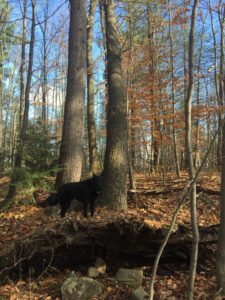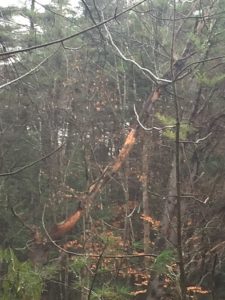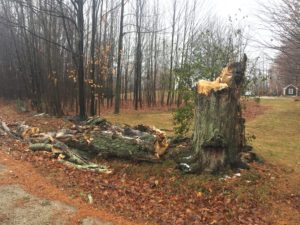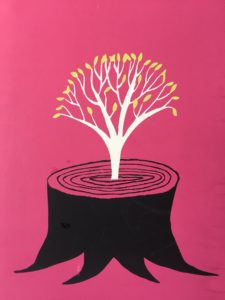Feeling For the Trees
Whenever I get tired of tracking my daily ups and downs, which is often, I find it refreshing to pay closer attention to the ups and downs of trees instead. Looking around outside with more vigor takes me out of my own limelight. It works well in November, or any other month for that matter.
And that surprising storm we had last month sure did a number on many of our tall, usually very sturdy neighbors. It’s disconcerting when you count on them to have the same posture, day after day; to be indicators of the stability you crave but do not always achieve; and then they fall. In a certain way, you need to rise to the occasion and gather your own resources.

Down by our pond, we had some drama. One strong gust of wind, or maybe just the continuous blowing all night, caused this poplar to keel over completely, roots and all. When I discovered it the next morning, lying this way right over the water so out of keeping with its usual dignified position soaring above the tranquil pond, the tree seemed to be saying, “Hey, if I had to come down, I made sure to come down with all my pieces still together; sink or swim.”
Then I got to wondering how my husband, always handy with a tractor and a chainsaw when he’s not tending churches, would approach this problem. Might most of the tree just disappear under the water— ker-plunk, in a big way— once he starting cutting from the bank? Ah, but I needn’t have worried, because he was a man with a plan…and a chain. My big brother Sandy, a farmer, presented our son Willie with a chain upon his college graduation, saying that it was probably the single most useful thing in his barn. After Rob reduced the weight of the trunk some by cutting what he could, he had his tractor do the pulling, and gradually that soggy tree emerged, as if it were a dog following a master’s command. Sadly, though, to borrow from a familiar oath, it will no longer be “one Nation (Tree) under God, indivisible.”

A day or so later, noticing more now, I came upon another completed up-rooted tree, this one a pine, not far away from the pond. But the upheaval here had preceded the most recent storm. A big slab of earth had been tilted, providing a nice little protected area underneath for creatures to make use of, ever since I could remember walking here. Nobody is in a hurry to disturb this leaning tower.
And then there are the trees dealing with other kinds of setbacks. Here’s one that must be embarrassed to have cracked in a way that imposes itself upon its neighbor. “I’d get out of your way if I could, really!!”

Even worse, this one is just a shadow of its former self, and cars drive by all day, gaping at the wounds.

Tree stumps are curious things, in general. They don’t exactly bespeak “Life!” And yet, as we all have experienced, being chopped down doesn’t necessarily mean being finished. A few years ago, I came upon this unusual greeting card; while I’ve been tempted to send it to any number of friends, I keep hanging onto it, probably because I need the message as much as anyone. And that pink color is so luscious.

Inside, it reads, cheerfully, “To new beginnings!”
I don’t know about you on your walks, but most of the stumps I come across do not have promising new growth right in their centers, reaching skyward. Once in a while, though, one does. Apparently, these green shoots with a whole lot of chutzpah are called “advantageous sprouts.” They really know how to make use of their resources; no shrinking violets here.
There is not universal agreement, however, that the efforts of these sprouts should be rewarded.Take a look at this short video, for example, from a tree guy who gets a lot of questions about this issue from clients. Do we stamp out the green shoots or let them flourish? Here, he shows us that we can have it both ways.
Sure, we in the human race feel as if we’re in charge much of the time. But i just know we’re better off when we try to imagine being inside somebody else’s bark once in a while.

